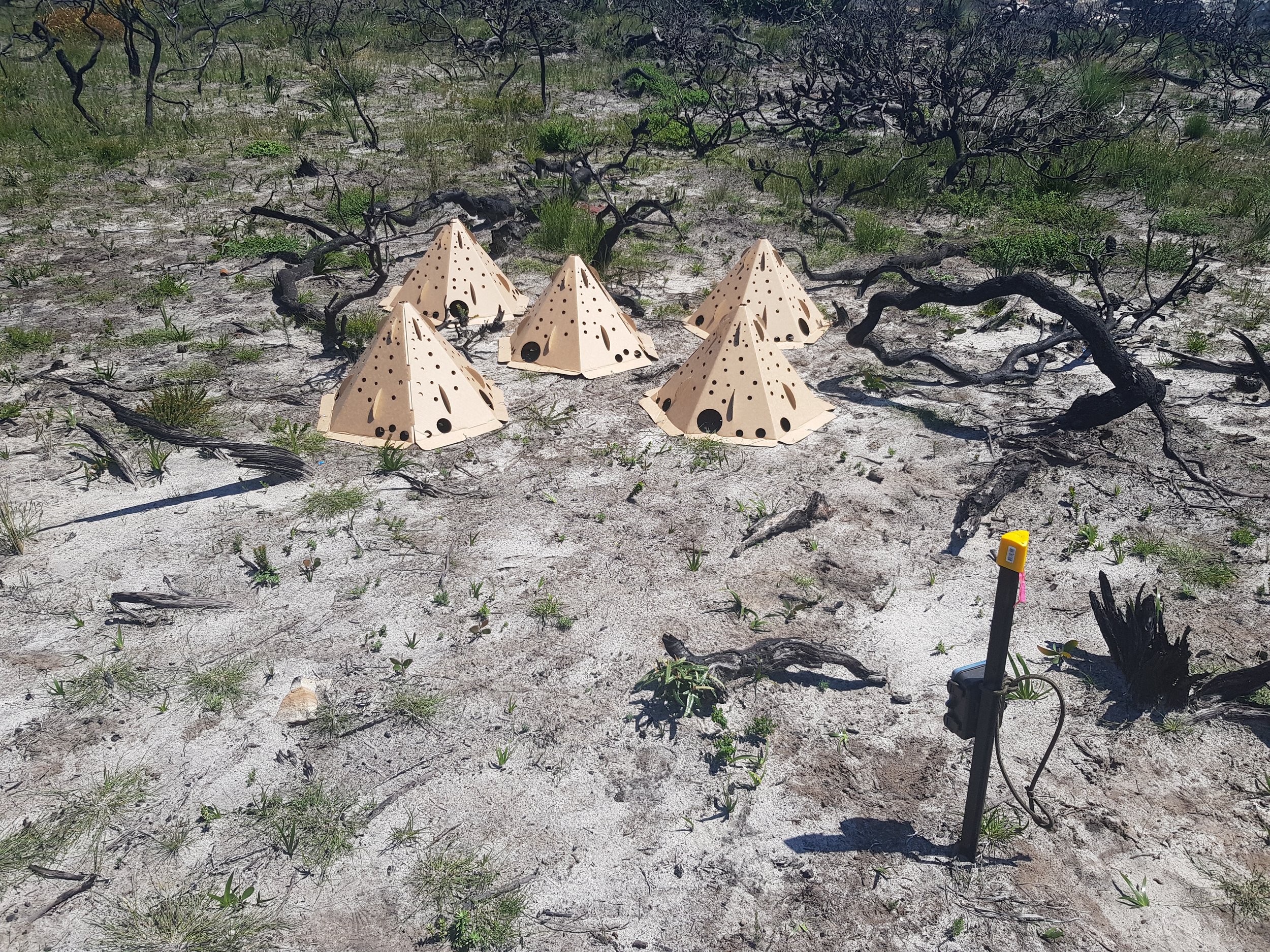
Real world testing.
Monitoring and evaluation.
Science-based innovations.
The field trials.
Real world testing.
Our products are rigorously tested in the field to ensure that they biodegrade as intended, over our target time frames (usually around 12 months). We use data loggers to continuously monitor the effects of the pods on temperature and humidity, and camera traps to observe different animal species using the pods.
We use an experimental approach, monitoring burnt habitats with and without pods, and compare them to unburnt sites as a reference point. This allows us to assess whether adding pods to burnt habitats provides benefits to wildlife and their habitat.
We have new field trials starting all the time, and we also provide guidance on how to effectively set up monitoring and evaluation programs for new sites and projects.
As new data comes in, we will continue to share our results publicly and in peer-reviewed scientific journals, so that you know you can trust that our products are rigorously scientifically evaluated.
The Results
ReHabitat Pods
A wide range of animal taxa have been seen using our classic ReHabitat Pods. These include pygmy and ringtail possums, numbats, mulgara, bush rats, swamp rats, long-nosed bandicoots, Pilliga mice and Shark Bay mice, antechinus, various skinks, goannas, small birds, kookaburras (sitting on top of the pods), and more.
The classic ReHabitat Pods last for around 12 months in the field, even under heavy rainfall conditions. The pyramid shape of the pods means that even once saturated, they simply slump very slightly inwards, but are held up by the internal triangular structure. They then dry out in the next bout of sunshine, and continue standing. We actually find that they eventually sort of “melt” from the bottom, looking like a witch’s hat that gets a gradually smaller peak.
Vegetation grows steadily up, around, and through the degrading pods, taking over as the cardboard disintegrates. This is exactly what we intended - no need to return and remove them from the regenerating habitat, risking damage to new growth. The ReHabitat Pods slowly sink out of site and turn into mulch as the habitat recovers.
ReHabitat pods appear to buffer extreme temperatures by a couple of degrees - being a few degrees cooler in the middle of the day, and few degrees warmer in the middle of the night, than ambient temperatures. They have little effect on humidity. When clustered tightly together, the temperature within the cluster (but outside any individual pod) is a few degrees warmer than ambient, and appears to be attractive to basking reptiles, whose ability to find food can be fueled by that extra bit of warmth.
ReHabitat Plant Pods
Field trials for ReHabitat Plant Pods have been underway on the Macquarie University campus and at Tocal Agricultural College (in partnership with The Groundswell Collective) for 5 months as of February 2025.
Initial results suggest that inside the plant pods is a few degrees cooler and a little bit drier than surrounding conditions, which is likely a good thing for Australian native plants typically used in bush regeneration or tree planting projects in most regions of Australia, which don’t like humidity and warmth (notwithstanding rainforest and tropical native species).
The Plant Pod tree guards stay wide open at the mouth and don’t collapse in to strangle seedlings, which is a common occurrence with plastic and the other thin cardboard alternatives currently available. None of our Plant Pod tree guards have been blown away or pulled off by herbivores like wallabies and kangaroos - by comparison, many plastic and cardboard ones have either been broken apart, or simply disappeared from site (blown away?).
Our Plant Pods are also doing a great job at suppressing weeds, where they have been sprayed down prior to planting. We think that the double-walled surrounds of the guard, firmly pinned into the ground through the 40 mm skirting, pose a formidable barrier for weeds to get through. By comparison, the plastic and thin cardboard alternatives are easily penetrated by returning weeds.
Next steps for field trials.
We have two Master of Research students doing large field trials of both classic ReHabitat Pods and the new Plant Pods in 2025.
One will do a large scale planting of over 300 seedlings on the Macquarie University campus comparing Plant Pods with plastic and no tree guard treatments. They will measure seedling survival and growth (form and biomass), weed encroachment, air and soil temperature and humidity/moisture, pH, invertebrate colonisation of the guards by invertebrates, visitation by vertebrate animals, and a range of other variables.
The other will do a field trial of classic ReHabitat Pods after prescribed burning undertaken by a local Council, and measure most of the same metrics as above except for seedling growth, and adding in metrics of vegetation recovery.
Stay tuned for some nice visuals from the field, and to find out their results!





